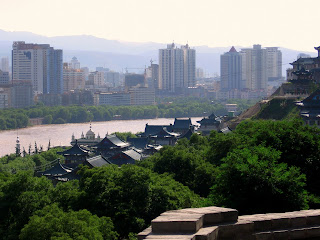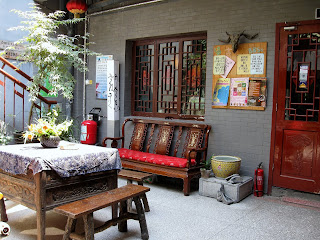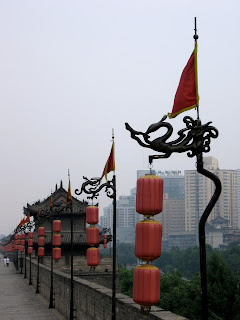
This time we had the soft sleeper car (the difference is not actually the firmness of the berth but the degree of privacy - in soft sleeper cars only four people share one compartment and it has an actual door, whereas in hard sleeper the compartment is open to the hallway - the reason we didn't get much sleep last time, some people went on talking till 1am, others got up at 6... you have to admire the ability of people to make themselves at home in a train car though - they started setting up makeshift tables and playing cards and everybody seems to travel with an inexhaustible supply of raamen noodles, which left us feeling like amateurs with our peanuts... not much for a breakfast when the train is two hours delayed. We abandoned our initial strategy of taking late trains (as we're late sleepers) and arriving not too early and switched to the Chinese schedule - going to bed at 11 and getting up at 6. And it's amazing how much you can get done in a day when you get up at 6 - once we get to the hotel, have showered, had a tea and are relaxed a little it's around 9 or 10 and we have the whole day ahead of us. Admitted, not the fittest of days, at least in my case.

We left Xi'An in pouring rain and arrived in Lanzhou in pouring rain. We were soon consoled, though, because we happened to have picked a really nice hotel (buying train tickets two days in advance and booking hotels on elong seems to work very well) for little money and got upgraded to a room with huge double bed, free standing bathtub and extra shower and all the little knickknacks (like bathrobes, fluffy slippers) you'd expect in a five-star hotel (no idea how many stars they had). A hot foam bath after a night on the train is heavenly :) The hotel also had a really nice decor, full of natural stones, and traditional furniture whose style varied on different floors. The service was over-the-top amazing, which had the effect that we couldn't just wander off somewhere, because someone with a secret-agent style headset would run over to us and ask if we needed help. They even had working internet!

So, we set off to explore Lanzhou, supposedly China's most polluted city - a title I doubt but we might just have had luck with the weather, with umbrella's borrowed from our super-hotel and went in search of a tea house to sit, snack, write and read. The one the Lonely Planet mentions didn't exist anymore, but it was surprisingly easy to find a tea house, i later noticed Lanzhou seems to be full of them. That was a life-time experience :) Not so much in terms of the tea (pretty bad) and food (typical buffet) or decor (kitschy but fitting), but the people! When we got there at 11:30 it was still pretty quiet, but then elderly people started to trickle in and when the lunch buffet was opened at noon there was a stampede to get to the best food (mostly the shrimp)

- all-you-can-eat is also very popular in China. 15min later the bowls were wiped clean. One old lady liked the food so much, she took her denture out of her mouth and licked it clean.
The sun started coming out. We left the battle field and headed out into the city, which is really like any other Chinese medium-sized (a few million inhabitants) city, but if you haven't seen one, then how can you know what I'm talking about? Basically, there is a "gentrified" downtown with western style shopping malls and chains like McDonalds and KFC. In smaller side streets you get the cheaper clothes and accessories and the not-yet-gentrified streets typically have grocery or fruit stores, household goods or shoe stores, and street food or noodle shops on the ground floor, with 5-6 storey apartment buildings (probably from the 60s) behind them.

The cleanliness and smell of these areas seems to be correlated with the amount of tourists the city gets - Xi'An was the nicest so far (at least inside the city walls), followed by Nanjing, Lanzhou, Jiayuguan. And the farther west we get, the more likely we run into really old neighborhoods without sewage system or even running water (in Lanzhou we witnessed people getting water with plastic containers from a little shed, which I suppose contains a well). Now, I'm all for preserving the old Hutong neighborhoods with the traditional courtyards, such as in Beijing, but those were really just brick huts, more barracks then courtyards. Not far from there new 20-30 storey apartment buildings are growing and I guess it's just a matter of time until those huts are gone - but how are those people supposed to afford living in the new high-rises? It's not like their land now is worth a lot, it's not downtown Beijing, where it's a good deal for the government to give the Hutong residents apartments in the outskirts of town and convert their old homes into museums or tear them down to erect shopping malls (or olympic facilities).

Anyways, after we had made our way through the shopping district and across the Zhong Shan (Sun Yat'sen) Bridge, a masterpiece of Russian-German-Chinese engineering spanning the Yellow River, we climb the hill on the other side, leading to the White Pagoda Park. From there we had amazing views onto the city.

Ok, the city is really not amazing, but it's squeezed between two mountain ridges, which gives it its weird, long-stretched form. It was kinda cool to sit in a tea house on top of the hill, which belongs to the Taoist temple, and hear the call of the Muezzin from the Minaret below... There are definitely more Muslims in Lanzhou than in Xi'An or anywhere in eastern China I have been so far, and we expect to see more the further west we get. Also, ethnic minorities become more and more visible, because of their clothing and facial features.

Since we had so much fun eating lamb skewers on the night market in Xi'An, we tried the same thing in Lanzhou - but the night market mentioned by our guide books had already been gentrified. Since it was already quite late, we headed for the nearest noodle shop on a quite dingy-looking unpaved street - after business the restaurants just piled their garbage in the middle of the road. Well, I don't know if you can see where this is going, but the next day we both came down with pretty bad food poising. The second time noodle soup with fried egg was the culprit! I was knocked out so badly, I spent all day in bed - good thing we had booked two nights in our fancy hotel. The hotel service was really attentive (invasive?), they called and asked why we had the "do not disturb" sign outside all day (actually, it's an electric sign, the switch also disables the door bell, so you are completely left in peace... well, until they call you to see if you're not doing anything "illegal, like sex" - quote from the hotel brochure - in your room. when I explained that I was sick, they came and brought me a hot-water bag and "red soup" - a sort of herbal tea, Chinese medicine. I felt somewhat better the next day, but I think that was mostly due to the Western medicine.

The last day we had booked another night train, so we still had a day to kill. None of us felt much like eating, and so we took the cable car up on the other mountain range. The little temple mentioned by the guide books has been expanded into a full-blown park with a fake waterfall and several more pagodas, playgrounds and makeshift tea houses. It seemed still halfway under construction and the large unconcealed garbage heaps here and there were quite a turn-off. But great views...

Noteworthy food - red Chinese dates (Jujube), soaked in wine and served with honey as a cold starter. Tea is often a mixture of green tea with flowers, dried fruit and rock sugar - the same stuff that is sold in Canada (and other places in the west?) at "My Cup of Tea" chain stores... And I always thought they had made this up! Apparently, it's just Western Chinese (or "Muslim" or "8 treasure") tea, I have never seen it in the east. Usually restaurants serve Dragon Well (from Hangzhou) or Bi Luo Chun tea (from Nanjing!)
 We got stuck here, because we believed the Lonely Planet that to make it from Langmusi to Songpan one needs to stay overnight. Well, it turns out they changed the bus schedule so that one can take the 7am bus to Zoiige and from there the 10am or 2:30pm bus to Songpan - but we found out too late. But whatever. It was entertaining in the sense that they really don't seem to get many tourists there, let alone foreigners. In the restaurant where we had lunch they couldn't stop giggling, even after I managed to successfully communicate with them in Chinese, they just couldn't get over themselves. One waitress was so afraid of us, she refused to come to our table and would send her colleague over instead. Just after we arrived, we opened the laptop to look on a map and immediately a crowd of 10 or so people surrounded us, talking animatedly about what the laowai were doing. They were helpful, though, and pointed us to the bank. When we had lunch in a hot pot restaurant (not bad) and B. went to the bathroom, I immediately had the neighboring table crowding and interrogating me. The usual "where are you from? How old? What do you do? Married? Kids?" So much for small talk... Several people felt obliged to welcome us "to China" :) Much nicer than the usual crowd trying to sell us stuff or rip us off. There was genuine curiosity, and although I wouldn't like to be the town's curio attraction every day, it was a nice change for once.
We got stuck here, because we believed the Lonely Planet that to make it from Langmusi to Songpan one needs to stay overnight. Well, it turns out they changed the bus schedule so that one can take the 7am bus to Zoiige and from there the 10am or 2:30pm bus to Songpan - but we found out too late. But whatever. It was entertaining in the sense that they really don't seem to get many tourists there, let alone foreigners. In the restaurant where we had lunch they couldn't stop giggling, even after I managed to successfully communicate with them in Chinese, they just couldn't get over themselves. One waitress was so afraid of us, she refused to come to our table and would send her colleague over instead. Just after we arrived, we opened the laptop to look on a map and immediately a crowd of 10 or so people surrounded us, talking animatedly about what the laowai were doing. They were helpful, though, and pointed us to the bank. When we had lunch in a hot pot restaurant (not bad) and B. went to the bathroom, I immediately had the neighboring table crowding and interrogating me. The usual "where are you from? How old? What do you do? Married? Kids?" So much for small talk... Several people felt obliged to welcome us "to China" :) Much nicer than the usual crowd trying to sell us stuff or rip us off. There was genuine curiosity, and although I wouldn't like to be the town's curio attraction every day, it was a nice change for once.















































